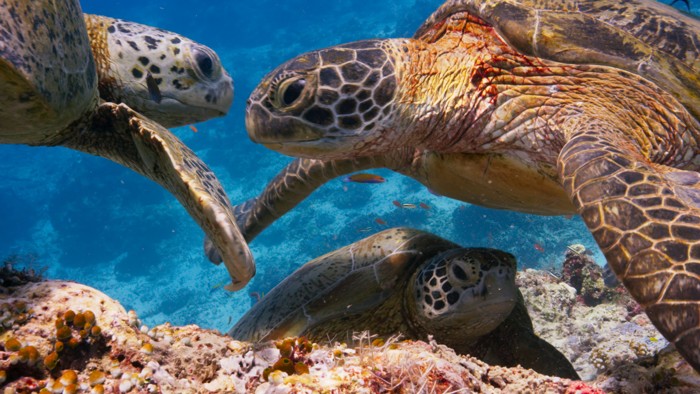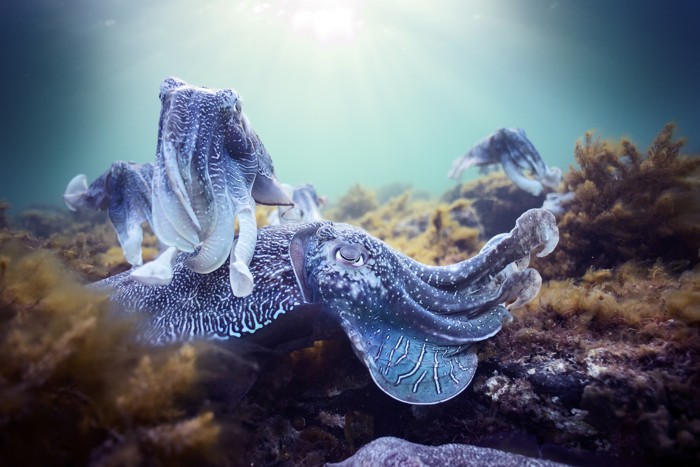Across seven episodes of Blue Planet II, viewers are treated to a number of wondrous images. Orcas stun schools of herring by slapping them with their tails. Cuttlefish mesmerize shrimp by splaying out their arms and sending moving clouds of pigment across their skin, like a living gif. Mobula rays cavort in the deep, stirring glow plankton as they move, creating an ethereal scene that looks like a clip from Moana. Cutthroat eels slink into a lake of super-salty water at the bottom of the ocean, and some tie themselves into knots in the throes of toxic shock. Pods of bottlenose dolphins and false killer whales meet in the open ocean, greeting each other as if reuniting with old friends.
The series first aired in the United Kingdom last year and finally premieres in the United States this Saturday. It is the latest program from the BBC’s indefatigable Natural History Unit—arguably the greatest producers of such documentaries in the world.
I remember exactly when and where I first came across their work—a VHS copy of Life on Earth, bought from the gift shop of London’s Natural History Museum at the age of 8. In the intervening decades, I have devoured almost every show that the NHU has cared to make. I celebrated David Attenborough’s recent 90th birthday by binge-watching all 79 episodes of his Life Collection for the umpteenth time, and ranking them all. I offer these tidbits, these credentials, to properly frame the following claim:
Blue Planet II is the greatest nature series that the BBC has ever produced.
It is almost transcendentally good—the product of a team that, after six decades of experience, is now at the height of its powers. The Blue Planet II crew traveled to 39 countries to capture over 6,000 hours of footage. They stuck their cameras into coral crevices. They hung off speedboats to film dolphins rocketing behind them. They literally stared into the abyss—and then repeatedly entered it. The resulting episodes, each narrated by David Attenborough in his trademark velvety tones, are hour-long distillations of wonder, featuring sequences that would be breathtaking had earlier shots left you with any breath to take away.
Consider the octopus from the “Green Seas” episode. As it goes about its business, ambushing wayward crabs and hiding in crevices, it becomes suddenly menaced by a pyjama shark—a small and slender predator that yanks it out of its hidey-hole. The two tussle. Even though the octopus finds itself at the wrong end of a shark, it manages to escape by—and major spoiler alert—slipping an arm into the shark’s gill slits to prevent it from breathing. It is released but now finds itself in open water, patrolled by more pyjama sharks. So—and again, spoiler warning—it grabs nearby shells with its suckers and arranges them into a protective dome. As a shark investigates, the octopus explodes out of its ersatz armor, and jets to safety.
Such behavior has never been witnessed by either TV audiences or scientists, and it is as thrilling a bit of television as exists. Here is a fight scene brought to you by millions of years of evolution, and weeks of stakeouts by ever-patient camera-people. It has drama, a plucky underdog (underpus?), and a twist ending.
That I included spoiler warnings for a nature documentary is telling. They are warranted, and often demanded by audiences. And they reflect that wildlife shows have gone far beyond stately theses (think early David Attenborough) or brash showboating (think Steve Irwin). They are now blockbuster events. They have plots that audiences care about not knowing beforehand. They come with trailers, posters, merchandise and, as in the case of Blue Planet II, a Hans Zimmer score. In showing nature’s spectacles, they have become spectacles in themselves.

This trend began, ironically enough, with the original Blue Planet series in 2001. It was the brainchild of filmmaker Alastair Fothergill, then the youngest-ever director of the NHU. He somehow convinced the BBC to spend $10 million on a seven-year shoot, making TheBlue Planet the most expensive natural-history series thus far created. The investment paid off. Over 12 million people tuned in to watch orcas running down a gray-whale mother and her calf; newly discovered species like the dumbo octopus with its earlike head flaps; and the now-obligatory sequences in which schools of small fish get obliterated by a sequence of predators—marlin, tuna, dolphins, birds, and as if that wasn’t enough, a whale.
The BBC had created landmark nature series before, like Attenborough’s seminal Life on Earth—but here was the true dawn of the nature documentary as worldwide event. Blue Planet was sold to over 50 countries. It included its own extras—10-minute segments that capped each episode to show how the marvelous shots were achieved. It was repackaged into a 90-minute film called Deep Blue that screened in movie theaters, the cinematic footage becoming truly cinematic. It spawned a live concert tour.
Fearing a world of shrinking budgets, The Telegraph wrote, “this may be the last television series of its kind”—a prediction that hasn’t aged well. Buoyed by the series’ success, Fothergill commissioned Planet Earth—an even more ambitious and more successful show that followed the same blockbuster template. More would follow—Life, Frozen Planet, Africa, Life Story, The Hunt, Planet Earth II, and now Blue Planet II—each one hewing to many of the same ideas that Blue Planet pioneered.
Along the way, the programs became less didactic, dialing down the lecturing and ratcheting up the drama to connect audiences with the animals they were seeing. Who can forget the marine iguanas of Planet Earth II, escaping from the jaws of hungry racer snakes? But in chasing drama, some of the shows became thinner and messier. Many episodes of Planet Earth II felt like glorious visual listicles—selections of (admittedly awesome) set pieces woven together by the flimsiest of narrative gossamer.
By contrast, the threads that hold Blue Planet II together are thick and tightly woven. Each episode flows. For example, the second episode, on the deep ocean, achieves narrative depth through actual depth, sinking deeper and deeper so that each new spectacle is anchored in space. Where previous series felt like they sacrificed the storytelling craft and educational density for technical wizardry and emotional punch, Blue Planet II finally marries all of that together.

Paradoxically, I suspect the series works so well because of the constraints of water. As I suggested in my review of Planet Earth II:
Nature documentaries have been limited by the same technology that makes them so compelling. When you can get beautiful, high-definition, slow-motion, ground-level shots of an animal, it’s not enough to just show it and start talking. You need build-up. You need to swoop in on the island of Komodo, follow a tail as it drags across a beach, catch a scaly body in the reflection of a tidal pool, and reveal a powerful clawed foot as it thumps into the sand—and only then can you show the entire Komodo dragon. The storytelling language of wildlife documentaries has become more cinematic, and every vignette becomes longer. That necessarily reduces the amount of material you can get through in a given hour.
My hunch is that it’s just harder to achieve the same effect underwater. When you’re filming in a world to which humans are so poorly adapted, cinematography cannot dominate storytelling in the same way.
There’s also the unfamiliar nature of the ocean and its denizens. The stars of Blue Planet II are not lions, chimps, meerkats, and polar bears—celebrities whose antics we know, and whose movements we can more easily interpret. They include mantis shrimp, Bobbit worms, Portuguese men-o’-war, and giant cuttlefish. The alien nature of these creatures forces a more didactic narration. Here, showing doesn’t work without also telling. Footage of corals, sea cucumbers, and sponges is meaningless without some explanation of what they’re doing.
Indeed, Blue Planet II repeatedly tells us not to underestimate creatures that we barely understand. It shows us an intelligent tuskfish that uses tools, an octopus and a grouper hunting cooperatively, a carnivorous worm that gets the better of fish, and trevallies leaping out of the water to snag passing terns. “There is a fish here,” says Attenborough, “that has a brain capable of calculating the air speed, altitude, and trajectory of a bird.” And don’t you forget it. I’ve had recent conversations with people who intuitively feel that the animal kingdom stops at the coastline—restricted to all that soars and walks. Blue Planet II says otherwise: It is a reminder of the animal kingdom’s fullest extent.
It is also a reminder of that kingdom’s imminent peril. “The health of our oceans is under threat,” says Attenborough in the second minute of the first episode. “They are changing at a faster rate than ever before in human history. Never has there been a more crucial time to reveal what is going on beneath the surface of the seas.”
In past documentaries, environmental problems have often been shunted to end episodes or spin-offs, hinted at briefly, or sometimes ignored altogether. But Blue Planet II not only devotes its entire final episode to humanity’s influence beneath the waves, but threads that influence into almost every episode. We don’t see the deep without learning about the devastation wreaked by trawling. We don’t meet coral reefs without seeing the horror of bleaching firsthand.
The final heartbreaking episode is entirely devoted to these problems. A killer whale family gets entangled in nets. A family of clownfish is drowned out by human-made noise. An albatross swallows plastic. These are not random animals. These are the same ones we have watched for weeks—those killer whales, those clownfish, that grouper and that octopus hanging out in a dead reef.
And in showing bleached reefs and acidifying oceans, Attenborough unequivocally pins the blame on carbon dioxide, released by burning fossil fuels. “This is man-made beyond question?” he asks a scientist. “Beyond question,” comes the reply. It’s a bold claim for the BBC, which has historically been criticized for its unwillingness to tackle the reality of climate change head-on. Here, too, is a mature Natural History Unit, at the top of its game and unafraid to speak out. We are the better for it.
Bagikan Berita Ini
















0 Response to "Blue Planet II Is the Greatest Nature Series Of All Time"
Post a Comment